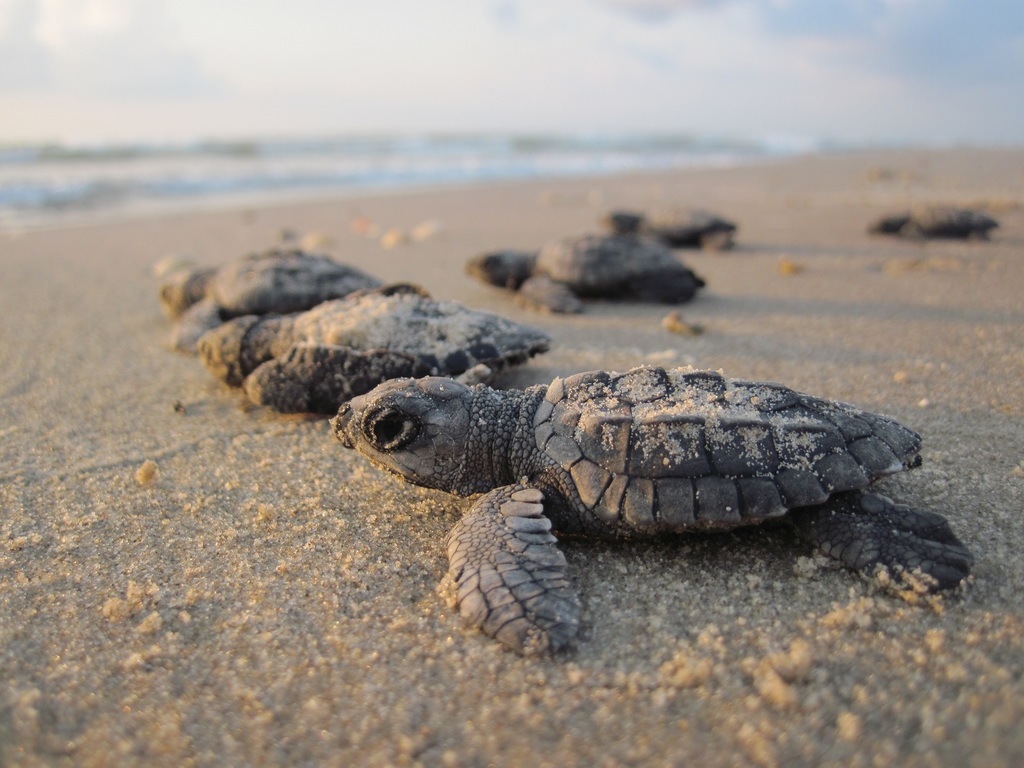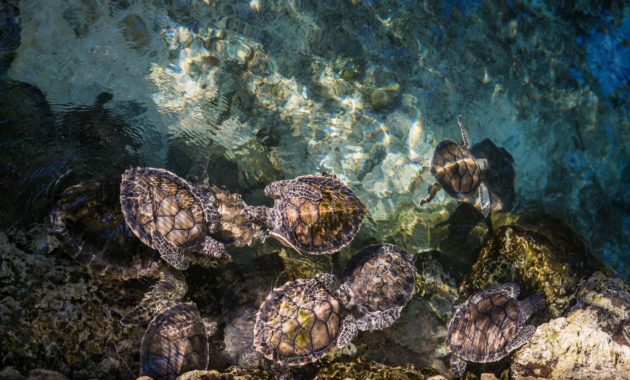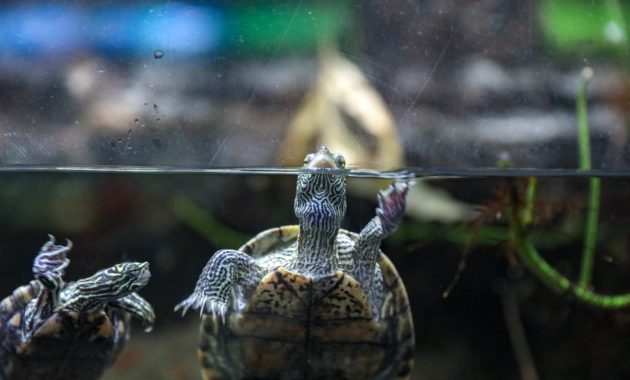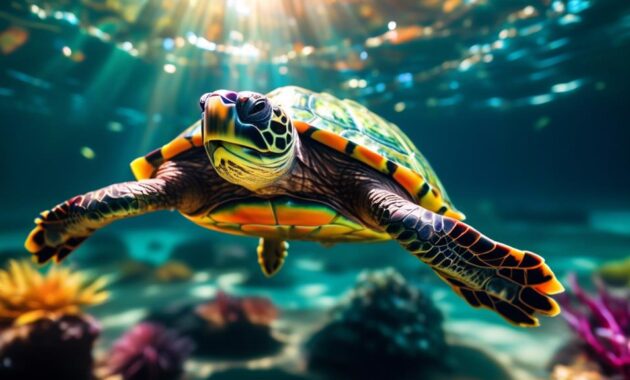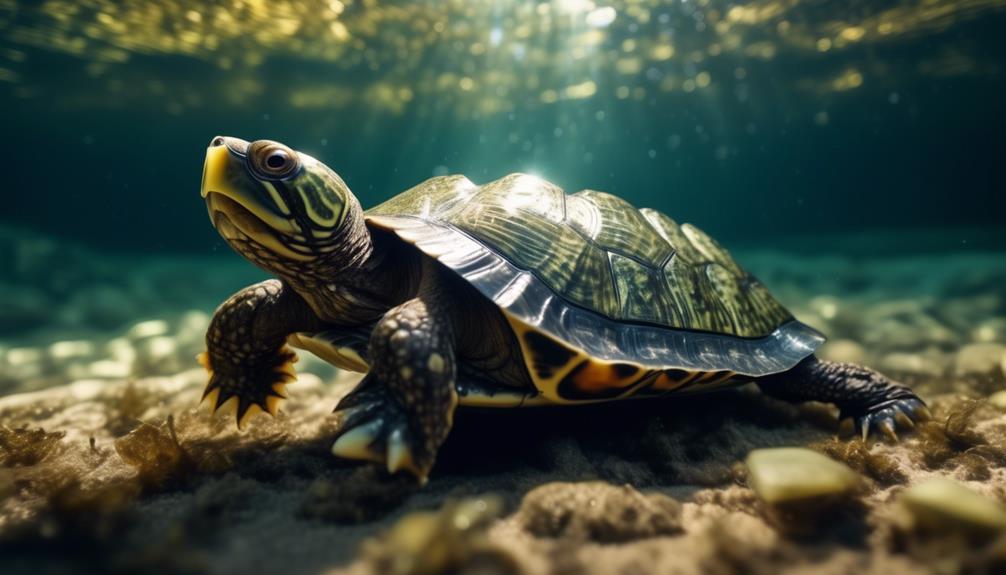
Step into the captivating world of the Flattened Musk Turtle, a hidden gem waiting to be explored. Like a well-guarded treasure, this rare creature possesses a unique allure that is sure to pique your curiosity.
Its flattened carapace, lacking a keel and adorned with a serrated back edge, sets it apart from its counterparts. But there is more to this remarkable turtle than meets the eye.
As you embark on this journey, prepare to uncover the secrets of its fascinating appearance, its low maintenance care requirements, and the wonders of its aquatic habitat.
Get ready to be captivated by the Flattened Musk Turtle’s remarkable story.
Key Takeaways
- The Flattened Musk Turtle is a small aquatic turtle with a flattened carapace and serrated back edge.
- It has a mottled black head and body, with an olive green color, spots on the snout, and narrow stripes on the neck.
- The turtle has a lifespan of 50 years and requires low maintenance care.
- It is native to Alabama and prefers small rivers and free-flowing creeks with vegetation and rocks in its habitat.
Description and Appearance
The Flattened Musk Turtle can be easily recognized by its small size, flattened carapace without a keel, and serrated back edge. This species of turtle has two barbels on its chin and webbed feet.
Males have thick and long spine-tipped tails. The upper shell of the Flattened Musk Turtle ranges from dark brown to yellowish brown or orange, with small black streaks and spots. The plastron is yellowish to pink. The head and body are mottled black, while the snout has olive green color with spots and the neck has narrow stripes.
Size, Lifespan, and Care Requirements
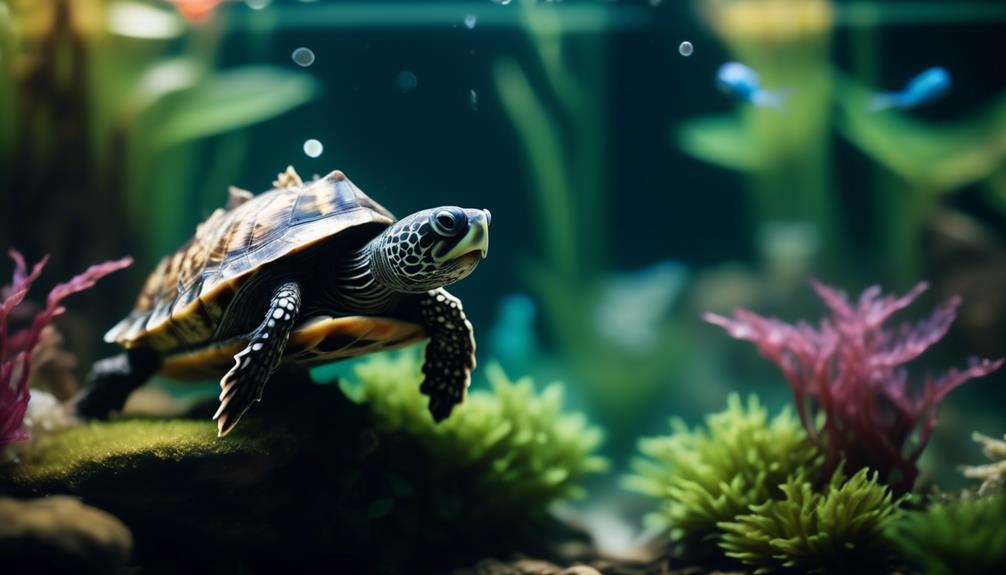
To properly care for a Flattened Musk Turtle, it’s important to understand its size, lifespan, and care requirements. These turtles are small in size, with their length varying.
As an aquatic turtle, they require a recommended minimum 40-gallon aquarium for adults, with a longer aquarium preferred for more swimming space. The water depth should be 4 inches for hatchlings and 8-12 inches for adults. Clean water with a high-quality filtration system is necessary, along with hiding places and a basking area equipped with a heat lamp and UV light.
The water temperature should be maintained at 72-78°F using a water heater, and the ambient air temperature in the mid-80s°F with a heater. Additionally, artificial or non-toxic live plants can be added to create a natural habitat. Due to their shy nature, it’s best to observe them rather than handle them.
Aquatic Habitat and Native Range
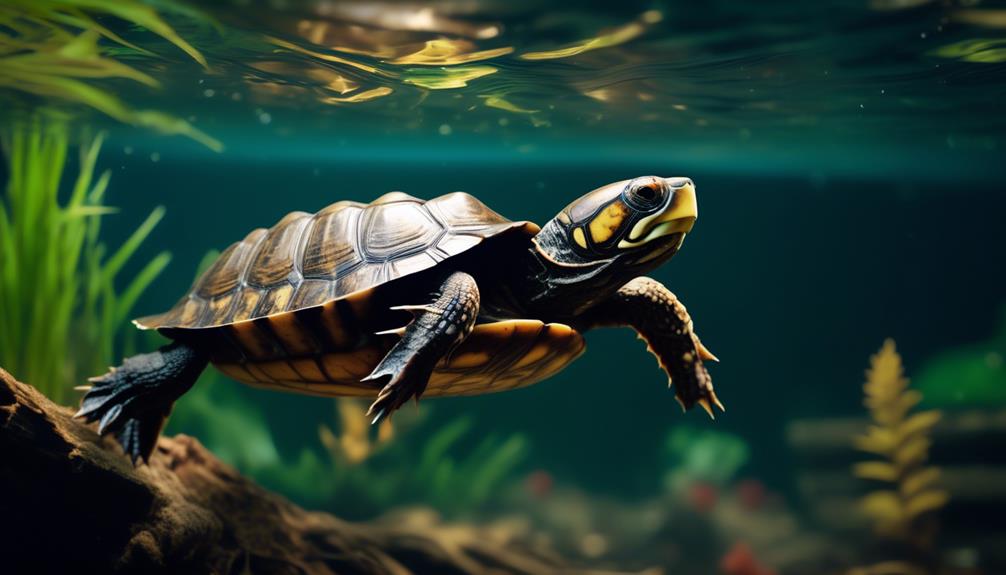
Understanding the aquatic habitat and native range of the Flattened Musk Turtle is essential for providing proper care. This small turtle is native to Alabama, particularly in the upper Black Warrior River system. It can be found in a range of lakes and streams but prefers small rivers and free-flowing creeks with vegetation and rocks.
In its natural habitat, the Flattened Musk Turtle thrives in these environments, where it can find ample food and shelter. When creating a habitat for this turtle, it’s important to replicate these conditions as closely as possible. Providing a tank with vegetation, rocks, and hiding places will help create a comfortable and stimulating environment for the Flattened Musk Turtle.
Low Maintenance and Easy Care
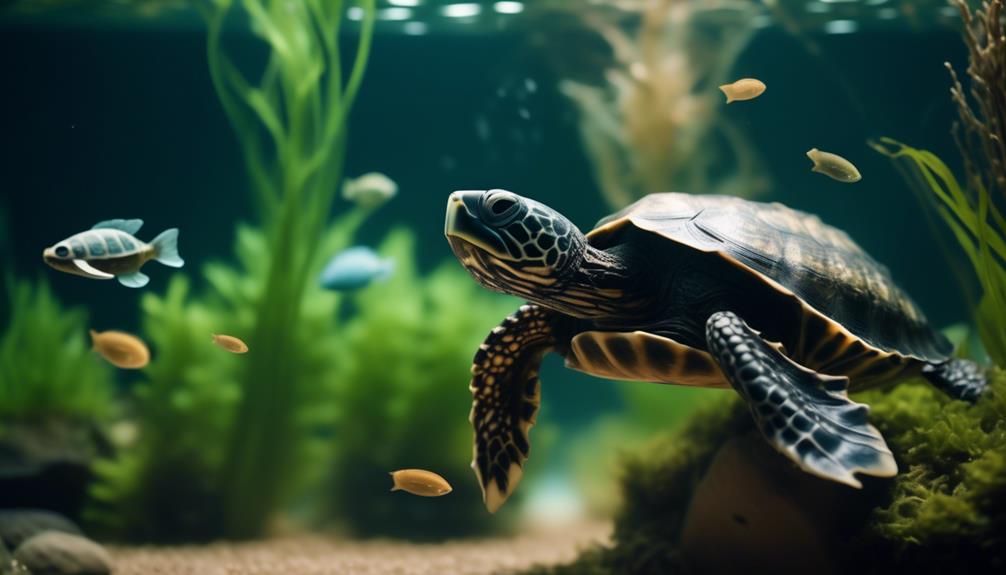
For an easy and low-maintenance pet, look no further than the Flattened Musk Turtle. Here are a few reasons why they make great companions:
- Minimal care requirements: These turtles are known for their low maintenance needs, making them ideal for busy individuals or first-time reptile owners.
- Simple habitat setup: All you need is a minimum 40-gallon aquarium with clean water, a filtration system, hiding places, and a basking area with heat and UV light.
- Easy feeding: Flattened Musk Turtles have a varied diet that includes commercial turtle pellets, live or frozen prey, and occasional fruits and vegetables.
- Long lifespan: With proper care, these turtles can live up to 50 years, providing you with many years of enjoyment and companionship.
With their easy care requirements and long lifespan, Flattened Musk Turtles are a great choice for anyone looking for a low-maintenance pet.
Unique Physical Characteristics
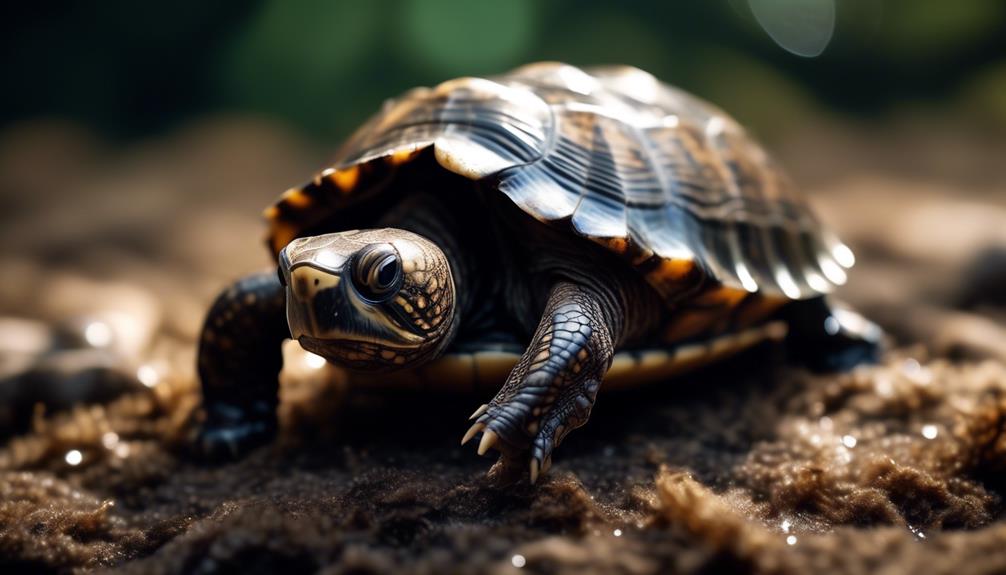
Now let’s take a closer look at the unique physical characteristics that set the Flattened Musk Turtle apart from other reptiles.
This small turtle has a flattened carapace without a keel, giving it a distinctive appearance. The back edge of its carapace is serrated, adding to its interesting features.
The Flattened Musk Turtle also has two barbels on its chin and webbed feet, adaptations for its aquatic lifestyle. Male turtles have thick and long spine-tipped tails, which further differentiate them from other species.
The coloration of the Flattened Musk Turtle varies, with the upper shell ranging from dark brown to yellowish brown or orange, and small black streaks and spots can be seen on it. The plastron, or the underside of the shell, is yellowish to pink.
The head and body of the turtle are mottled black, while the snout has olive green color with spots and the neck has narrow stripes.
These physical characteristics make the Flattened Musk Turtle a truly remarkable and unique reptile.
Recommended Tank Setup
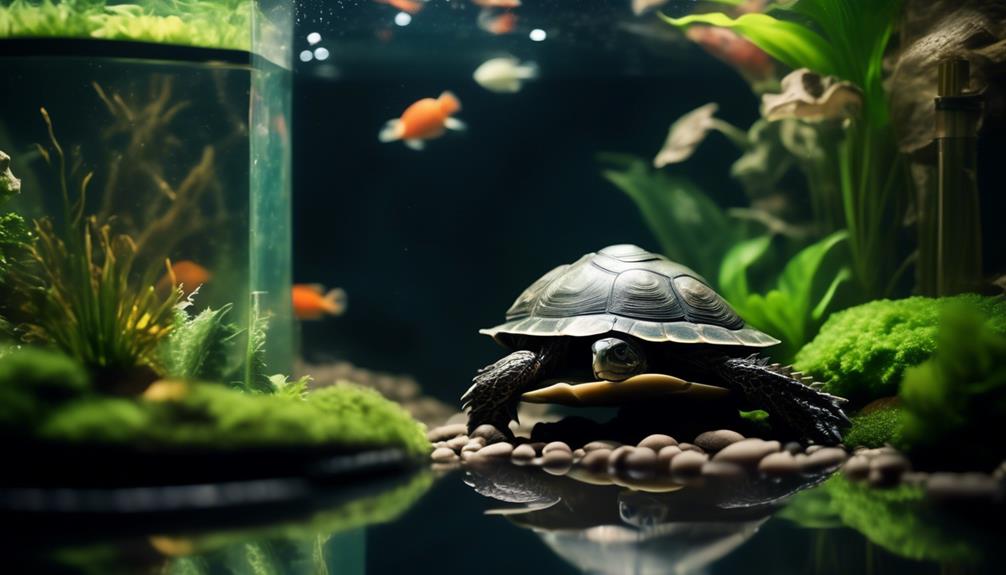
To create an optimal habitat for your Flattened Musk Turtle, consider the following recommended tank setup:
- Tank Size: Provide a minimum 40-gallon aquarium for adult turtles, but a longer tank is preferred to allow for more swimming space.
- Water Depth: For hatchlings, maintain a water depth of 4 inches, while adults require a depth of 8-12 inches.
- Filtration System: Ensure clean water by using a high-quality filtration system to remove impurities.
- Basking Area: Include a basking area with a heat lamp and UV light for your turtle to climb out of the water and regulate its body temperature.
Temperature and Lighting Requirements
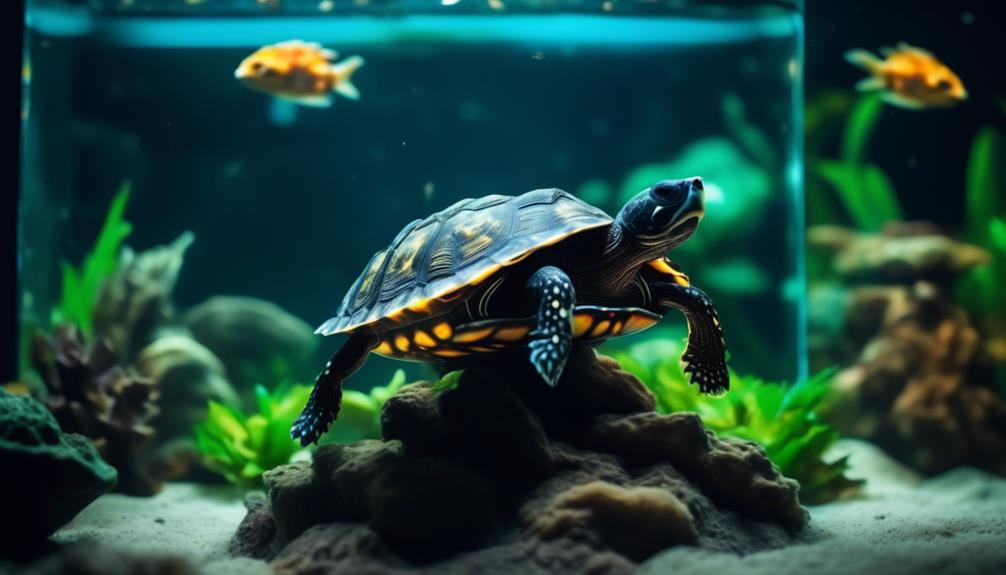
As you set up the recommended tank for your Flattened Musk Turtle, it’s important to understand the temperature and lighting requirements for their optimal health and well-being.
These turtles are ectothermic, which means they rely on external heat sources to regulate their body temperature. In order to provide the ideal environment, you should maintain a water temperature of 72-78°F using a water heater.
Additionally, the ambient air temperature should be in the mid-80s°F, which can be achieved by using a heater in the tank. To meet their lighting needs, it’s essential to install a heat lamp and UV light for a basking area.
This will help simulate natural sunlight and provide necessary UV radiation for their overall health. Proper temperature and lighting conditions are crucial for the well-being of your Flattened Musk Turtle, so make sure to monitor and maintain them consistently.
Water Quality and Filtration
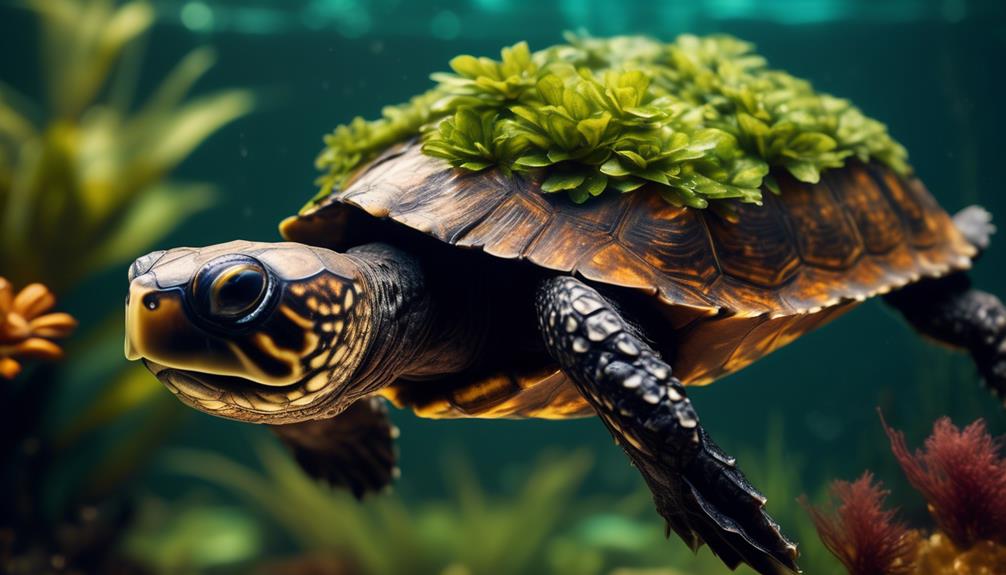
Maintaining proper water quality and filtration is essential for the health and well-being of your Flattened Musk Turtle. Here are four important factors to consider:
- Water Temperature: The ideal water temperature for your turtle is between 72-78°F. Use a water heater to maintain a consistent temperature and ensure your turtle’s comfort.
- Water Depth: Hatchlings require a water depth of 4 inches, while adults need 8-12 inches for swimming. Providing adequate water depth allows your turtle to engage in natural behaviors and promotes exercise.
- Filtration System: Invest in a high-quality filtration system to keep the water clean and free from contaminants. Regularly clean and maintain the filter to ensure its effectiveness.
- Water Quality: Regularly test the water for ammonia, nitrite, nitrate, and pH levels. Maintain proper water quality by performing regular water changes and removing any excess waste or uneaten food.
Feeding and Nutrition
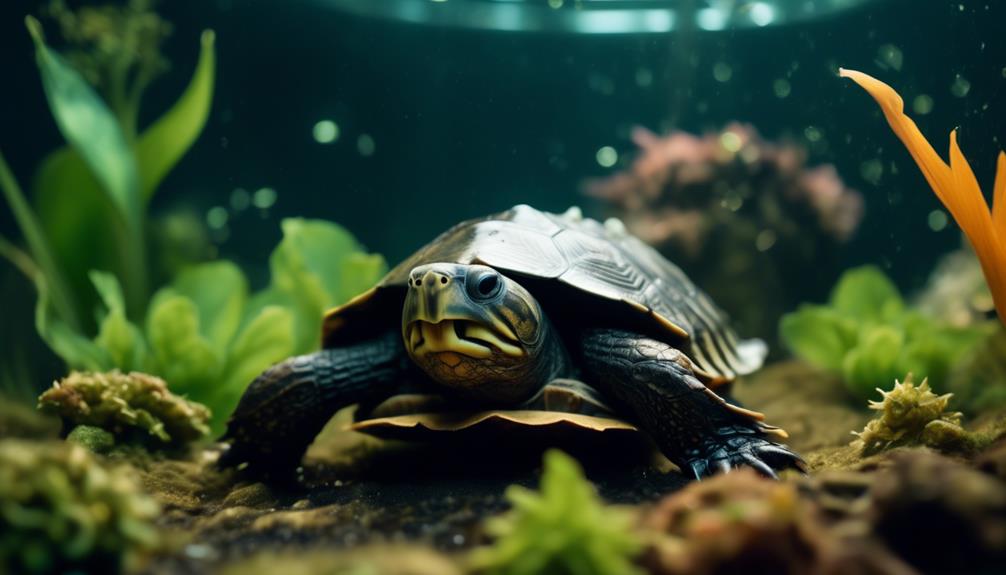
Feeding and providing proper nutrition is essential for the health and well-being of your Flattened Musk Turtle. These turtles are omnivorous, meaning they eat a combination of plant and animal matter. It is important to offer a varied diet to ensure they receive all the necessary nutrients. Here is a table outlining the ideal diet for your Flattened Musk Turtle:
| Food Type | Examples |
|---|---|
| Animal Matter | Insects, small fish, shrimp, earthworms |
| Plant Matter | Leafy greens, aquatic plants, fruits |
| Commercial Turtle Pellets | High-quality pellets specifically formulated for turtles |
| Calcium Supplement | Cuttlebone, calcium powder |
Remember to offer a balanced diet and monitor your turtle’s eating habits. Feed them daily, adjusting the amount based on their size and activity level. Additionally, ensure they have access to clean, freshwater at all times. With proper feeding and nutrition, your Flattened Musk Turtle will thrive and live a long, healthy life.
Observing Vs Handling
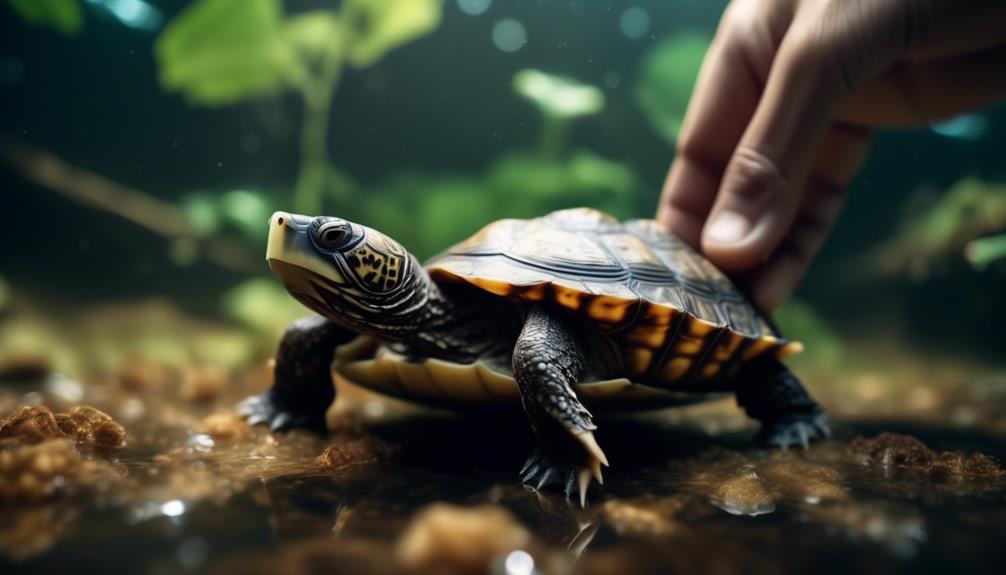
When interacting with Flattened Musk Turtles, it’s important to understand the difference between observing and handling them. Here are four key points to consider:
- Respect their natural behavior: Flattened Musk Turtles are shy creatures that thrive in their aquatic habitat. Observing them allows you to appreciate their unique behaviors and movements without causing stress or harm.
- Minimize stress: Handling can be stressful for these turtles, as it disrupts their natural routine and may cause them to feel threatened. By observing from a distance, you can ensure their well-being and help them feel secure in their environment.
- Avoid injuries: Flattened Musk Turtles have sharp claws and a strong bite. Handling them without proper experience and care can result in injuries for both you and the turtle. Observing from afar eliminates the risk of accidents.
- Preserve their habitat: Handling these turtles can potentially damage their delicate aquatic habitat. By observing them in their natural environment, you contribute to the conservation of their ecosystem and help protect these remarkable creatures for future generations.
Comparison With Other Musk Turtle Species
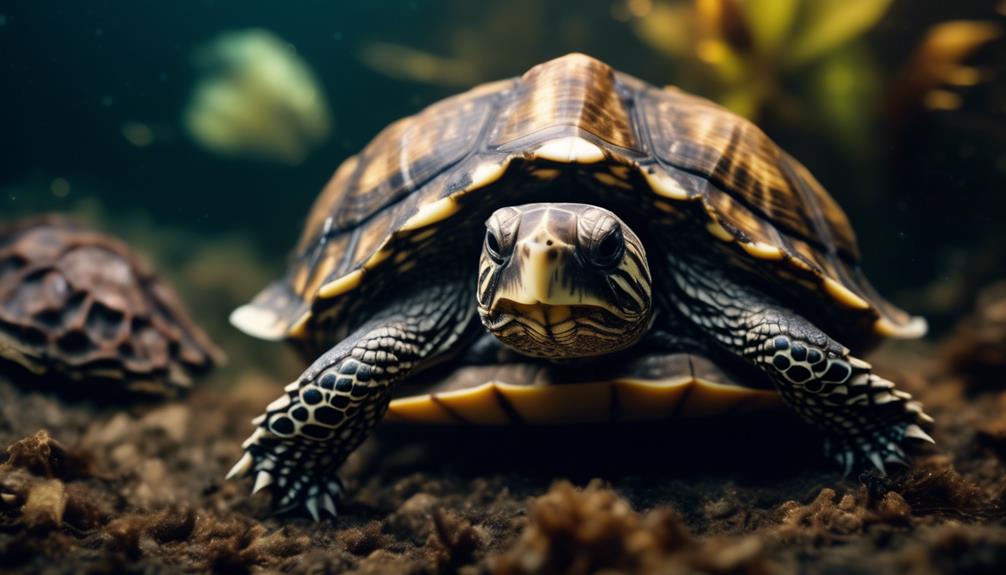
The Flattened Musk Turtle can be compared to other Musk Turtle species in terms of their physical characteristics and natural habitats. In terms of physical appearance, the Flattened Musk Turtle is small in size and has a flattened carapace without a keel. It also has a serrated back edge of the carapace and two barbels on its chin. Similarly, other Musk Turtle species such as the Razorback Musk Turtle, Loggerhead Musk Turtle, Stripe-Necked Musk Turtle, and Common Musk Turtle share similar physical characteristics.
When it comes to their natural habitats, the Flattened Musk Turtle prefers small rivers and free-flowing creeks with vegetation and rocks. This is also true for other Musk Turtle species.
Understanding these similarities can help us appreciate the unique qualities and adaptability of the Flattened Musk Turtle and its counterparts in the Musk Turtle family.
Conservation Status and Threats
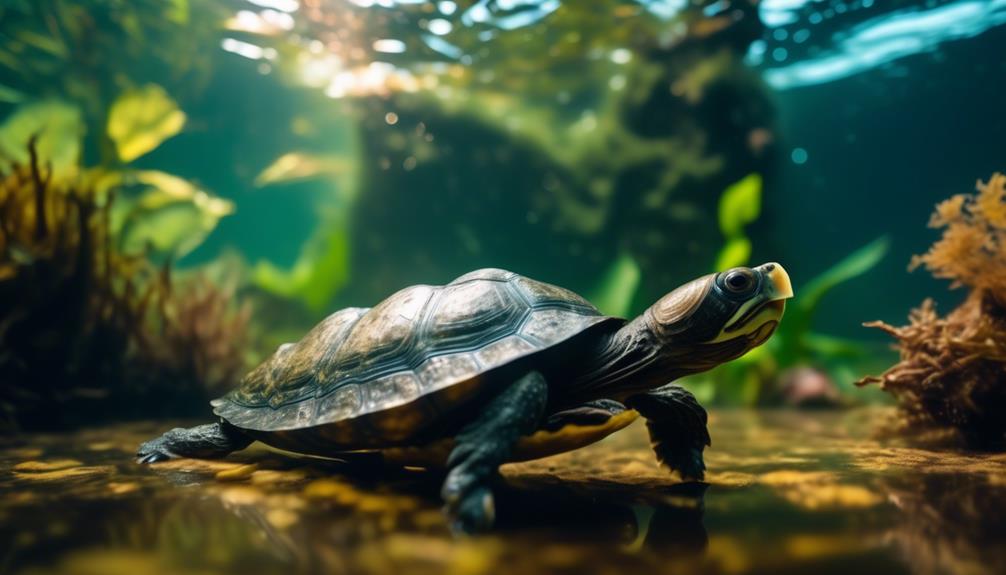
Conservation efforts and potential threats to the Flattened Musk Turtle are crucial factors to consider in ensuring the survival of this species. Here are four important points to understand about its conservation status and threats:
- Habitat loss: The destruction of its native habitat, including the loss of small rivers, free-flowing creeks, and vegetation, poses a significant threat to the Flattened Musk Turtle.
- Pollution: Water pollution, caused by industrial waste, agricultural runoff, and other human activities, can have detrimental effects on the health and survival of these turtles.
- Illegal pet trade: The Flattened Musk Turtle is often sought after for the exotic pet trade, leading to the unsustainable collection of these turtles from the wild.
- Climate change: Rising temperatures, altered rainfall patterns, and other climate-related factors can negatively impact the Flattened Musk Turtle’s habitat and overall population.
It is crucial that conservation efforts focus on addressing these threats to ensure the long-term survival of this rare and remarkable species.
Tips for Choosing and Caring for a Flattened Musk Turtle
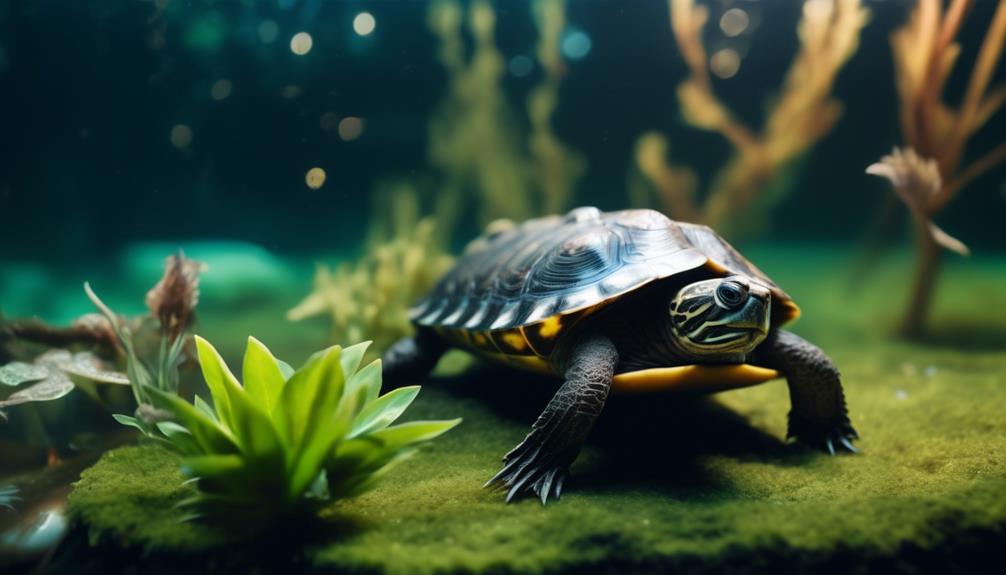
To ensure the health and well-being of a Flattened Musk Turtle, it’s important to consider these tips for choosing and caring for this unique aquatic species.
When choosing a Flattened Musk Turtle, look for a small turtle with a flattened carapace without a keel and a serrated back edge. It should have two barbels on its chin and webbed feet.
For proper care, provide a minimum 40-gallon aquarium with clean water and a high-quality filtration system. The water depth should be 4 inches for hatchlings and 8-12 inches for adults.
Create a habitat with hiding places, a basking area with a heat lamp and UV light, and water and air temperatures in the appropriate range. Use large gravel, silt, or sand as substrate and consider adding artificial or non-toxic live plants.
Remember that Flattened Musk Turtles are shy and should be observed rather than handled.
Frequently Asked Questions
Are Flattened Musk Turtles Endangered or Protected?
Flattened Musk Turtles are not currently listed as endangered or protected. They can be found in Alabama and are native to the state. However, it’s always important to respect and preserve their natural habitat.
Can Flattened Musk Turtles Live in Outdoor Ponds?
Yes, flattened musk turtles can live in outdoor ponds as long as the pond meets their specific requirements such as proper water depth, vegetation, rocks, and a suitable temperature range.
How Often Should the Water in the Tank Be Changed?
You should change the water in the tank for your flattened musk turtle regularly. Aim for at least once a week to ensure clean water and a healthy environment for your pet.
Are Flattened Musk Turtles Social Animals?
No, flattened musk turtles are not social animals. They are shy and prefer to be observed rather than handled. It’s best to provide them with a comfortable and quiet habitat.
Can Flattened Musk Turtles Be Kept With Other Turtle Species?
No, flattened musk turtles should not be kept with other turtle species. They are shy animals that prefer to be observed rather than handled, so it’s best to provide them with their own separate habitat.
What Are the Key Differences Between the Loggerhead Musk Turtle and the Flattened Musk Turtle?
The fascinating loggerhead musk turtle discovery has shed light on the key differences between the loggerhead musk turtle and the flattened musk turtle. While both species are similar in size and habitat, the flattened musk turtle can be identified by its smooth carapace, while the loggerhead musk turtle has a keeled carapace.
Conclusion
So, if you’re looking for a unique and captivating pet, the Flattened Musk Turtle is definitely worth considering.
With its distinctive appearance and low maintenance care requirements, this remarkable creature will bring joy and wonder to any turtle enthusiast.
Whether you’re observing its unique physical characteristics or creating the perfect aquatic habitat, caring for a Flattened Musk Turtle is a rewarding experience.
Don’t miss out on the opportunity to embark on an exciting journey with this rare and remarkable creature.

